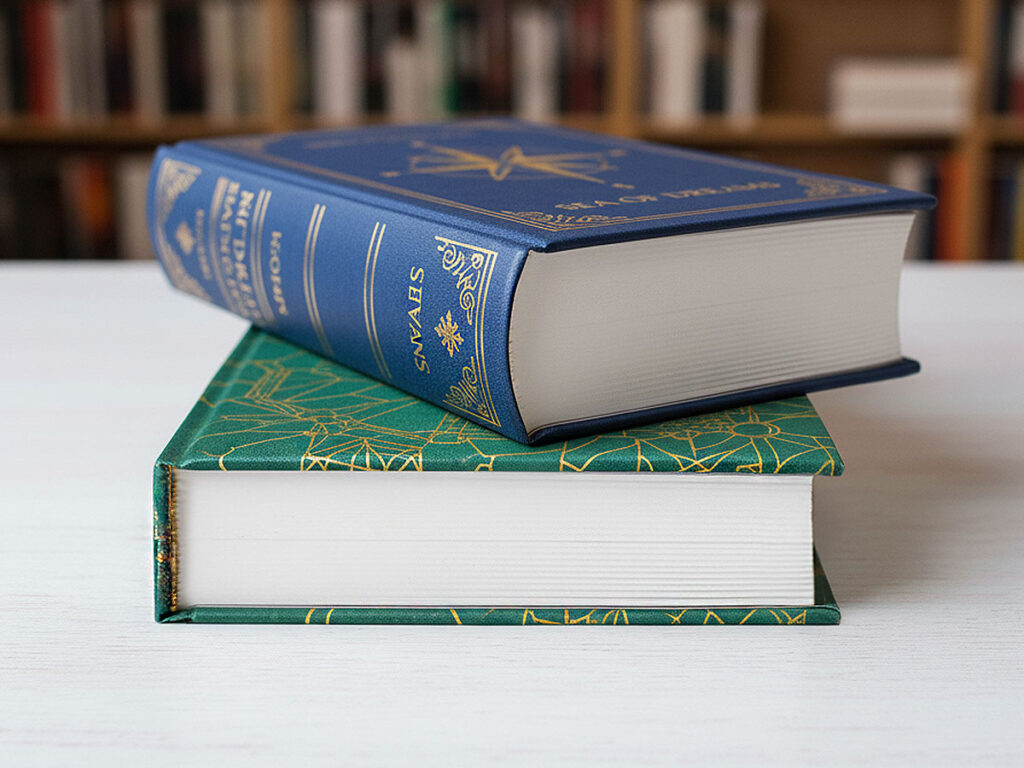
One of the decisions to be made when ordering a hardcover book print run is the choice of its spine type. At Books Factory, we offer two possibilities: a straight spine and a rounded spine. Each of these solutions has its own advantages and specific applications, which affect the final appearance, durability, and functionality of the publication. In this article, we will explain the types of book spines, discuss their characteristics, and advise on how to choose a book spine that meets your expectations and is best for your project.
What is a book spine?
In printing and bookbinding terminology, the term spine refers to two related elements:
- The spine of the book block, i.e., the edge where the pages or signatures are permanently joined.
- The spine of the cover, which is the outer part of the binding that connects the front and back covers, while also protecting the spine of the book block.
It is on the outer surface of the cover’s spine that key information such as the title, author’s name, or publisher’s logo is placed, making the book easy to identify on a shelf. The spine thus serves a dual role: structural – responsible for the book’s durability and ease of opening – and aesthetic/informational.
Types of Spines at Books Factory
In our digital printing house, the choice between a straight and a rounded spine is available for hardcover books. For softcover (paperback) bindings, a flat spine is used as standard. Below, we present the differences between a straight and rounded spine, which are worth knowing before making a decision.
Straight Spine – Minimalism and Modernity
A straight spine (or flat spine) is a solution where the spine of the book block is not rounded. The cover spine also remains flat and joins the covers at a right angle, creating sharp edges. This gives the publication a modern and elegant look on the shelf. Features of a flat spine:
Features of a straight spine:
- High aesthetic value: a straight spine is associated with minimalism and modern design.
- Clarity: the flat surface makes it easy to place text legibly.
- Cost-effectiveness: producing books with a straight spine is less labour-intensive and therefore cheaper than with a rounded spine.
- Versatility: it is an excellent choice for fiction, guidebooks, corporate materials, or books with a small to medium page count.
A certain limitation may be reduced durability and flexibility in the case of very thick volumes, which can be more susceptible to the stress created when opening.
Rounded Spine – Classic and Prestigious
rounded book spine is a traditional solution used in hardcover bindings, especially for high-volume publications. To achieve this shape, the spine of the book block undergoes a rounding process. In many cases, this is followed by backing, which involves forming grooves at its edges where the cover boards will be set. Only then is the cover fitted to the formed book block, with its spine reflecting the block’s convex profile.
Features of a rounded spine:
- Exceptional durability: the rounded construction compensates for stress better, making the book more resistant to mechanical damage and frequent use.
- Comfort of use: the publication opens more easily, and its pages lay flatter when open.
- Elegant appearance: the rounding harks back to classic bookbinding craftsmanship, lending the book a prestigious and refined character.
Limitations include a slightly higher cost and potentially longer production time, resulting from the more complex technological process. A rounded spine is ideal for albums, encyclopaedias, collector’s editions, academic books, and classic literature.
Which spine should you choose for your hardcover book?
The decision depends on the character, page count, and intended use of your publication.
- Choose a straight spine if you want your book to have a modern, minimalist look, it has a medium page count, and you are targeting the fiction, guidebook, or business publication segment.
- Choose a rounded spine if your priority is maximum durability, a prestigious character, and reading comfort, and your publication is an album, a special edition, or a high-volume book.
Choosing the right spine is an important element that affects the book’s functionality and its perception by readers. We hope this comparison will help you make the best decision for your project at Books Factory.
You can quickly get a quote for a hardcover binding in our calculator.
